
Lesson showing how to factor quadratics specifically when leading coefficient is not 1.
- Subject:
- Mathematics
- Material Type:
- Lesson Plan
- Provider:
- EngageNY
- Date Added:
- 04/02/2018

Lesson showing how to factor quadratics specifically when leading coefficient is not 1.

Lesson with application of factoring quadratic expressions and word problems.
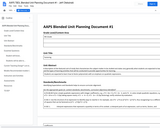
Students are expected to learn how to factor polynomials with an emphasis on quadratic expressions.

Students apply knowledge of exponential functions and transformations of functions to a contextual situation.

Students rewrite quadratic expressions given in standard form, ax2 + bx + c (with a = 1), in the equivalent completed-square form, a(x - h)2 + k, and recognize cases for which factored or completed-square form is most efficient to use.

Students solve complex quadratic equations, including those with a leading coefficient other than 1, by completing the square. Some solutions may be irrational. Students draw conclusions about the properties of irrational numbers, including closure for the irrational number system under various operations.

Students will be shown step by step how to set up a quadratic equation in order to factor it.

CK-12 Foundation's Algebra FlexBook is an introduction to algebraic concepts for the high school student. Topics include: Equations & Functions, Real Numbers, Equations of Lines, Solving Systems of Equations & Quadratic Equations.

In this Khan Academy activity, students will factor difference of squares problems.

In this Khan Academy activity, students will factor difference of squares problems.

In this Khan Academy activity, students will factor monomials.
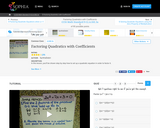
Students will be shown step by step how to set up a quadratic equation in order to factor it.
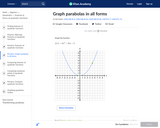
In this Khan Academy activity, students will graph a parabola given any form,
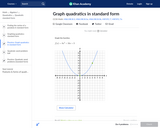
In this Khan Academy activity, students will graph a parabola given its standard form.
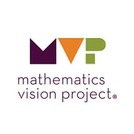
The purpose of this task is to verify that the properties of exponents students know for
integer exponents also work for rational exponents. In the context of writing exponential equations
to represent the amount of interest earned over smaller intervals of time than annually, students
will solidify their understanding of working with rational exponents in conjunction with the
properties of exponents.

In this lesson, the concept of factoring quadratic equations to obtain the zeros/solutions through the proper formula is discussed.

Students are expected to learn how to factor polynomials with an emphasis on quadratic expressions.This a remix of the original unit plan that includes links to specific Kahoot games for formative assessment.
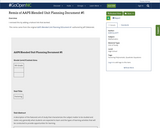
I remixed this by adding a Kahoot link that worked. This remix came from the original AAPS Blended Unit Planning DOcument #1 authored by Jeff Oleksinski.
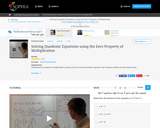
Understand and apply the multiplication property of zero to solve quadratic equations with integral coefficients and integral roots.

This lesson will teach students to factor trinomial expressions of the form x^2 + bx + c. Students will use algebra tiles to identify the binomial factors and the graphing calculator to verify the result. In addition, students will identify the x-intercepts and y-intercepts of each trinomial function and explore relationships between the trinomial x^2 + bx + c and its factored form (x + m)(x + n).